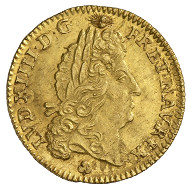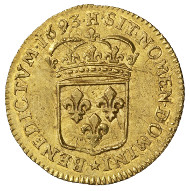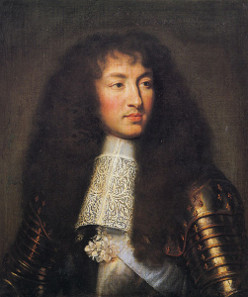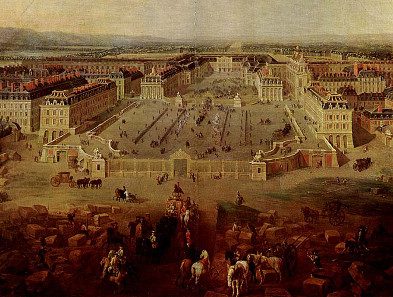Human faces, part 43: The thrifty Sun King
courtesy of the MoneyMuseum, Zurich
translated by Teresa Teklic
Why was the human head the motif on coins for centuries, no, for millennia? And why did that change in the last 200 years? Ursula Kampmann is looking for answers to these questions in her book “MenschenGesichter” (“Human faces”), from which the texts in this series are taken.
Louis XIV, King of France (1643-1715). Louis d’or 1693, La Rochelle. Head of Louis, to the right. R. Crowned arms with fleur-de-lis. © MoneyMuseum, Zurich.
On 17 August 1661, the French minister of finance, Nicolas Fouquet, entertained his king at the Chateau de Vaux-le-Vicomte. It was the most splendid castle of his time. It belonged to Fouquet, who had invested enormous sums of money into its construction. And that while the royal treasury was as empty as it could ever be.
What Fouquet did not know was this: Louis was already thinking about his discharge because the king and his new financial expert were more than suspicious of Fouquet’s economic transactions. Already on 5 September, Louis had Fouquet taken prisoner and thrown into the dungeons for the rest of his life.
Charles Le Brun, portrait of Louis XIV, 1661. Source: Wikicommons.
The king immediately began to review the finances and what he found surpassed his worst nightmares. The national budget was built on short-term credits from private investors, which were repaid with high interest together with the tax payments. What the actual state revenue was nobody could tell right away, considering the chaotic tax system. On closer inspection Colbert realised that Fouquet had embezzled almost half of France’s state revenue. Still worse, the entire revenue of the current year had already been spent and an additional 26 million livres in anticipation of the 1662 revenue – bills adding up to 9.5 million livres were still unpaid.
Strict austerity measures were the only way to avoid state bankruptcy. And Louis XIV was willing to implement them. He had a small, red leather booklet manufactured for him, in which he personally kept record of all revenues and expenditures. So the king could tell precisely how much money was in the royal treasury at all times. The strict control bore fruit. As early as 1664, France was the country with the healthiest finances in Europe. The monarch was even able to generate a surplus of half a million livres, a fact that can only be truly appreciated knowing that there was a deficit of more than 30 million in 1662.
Pierre-Denis Martin, Palace of Versailles at the end of Louis’ XIV reign, 1722. Source: Wikicommons.
So France’s budget was rehabilitated and federal revenue even outbalanced federal expenditures in the following years. It was thanks to these surpluses that financing the construction of Versailles was a walk in the park for Louis. Only the countless wars and their incalculable costs would ruin the kingdom. And so the Sun King reminded his successor on his death bed: “Try to remain at peace with your neighbours. I loved war too much. Do not follow me in that or in overspending.”
We remain in France for the next episode. It is the time of the French Revolution and we will talk about a failed attempt at escape by Louis XVI.
You can find all episodes in the series here.
A German edition of the book “Menschengesichter” is available in print and as ebook on the site of the Conzett Verlag.









